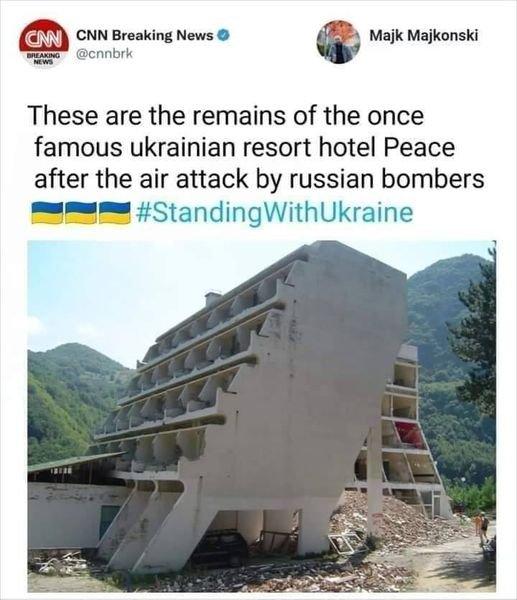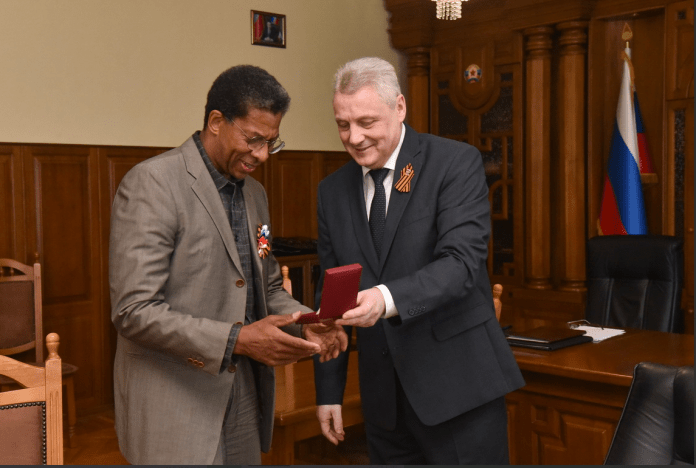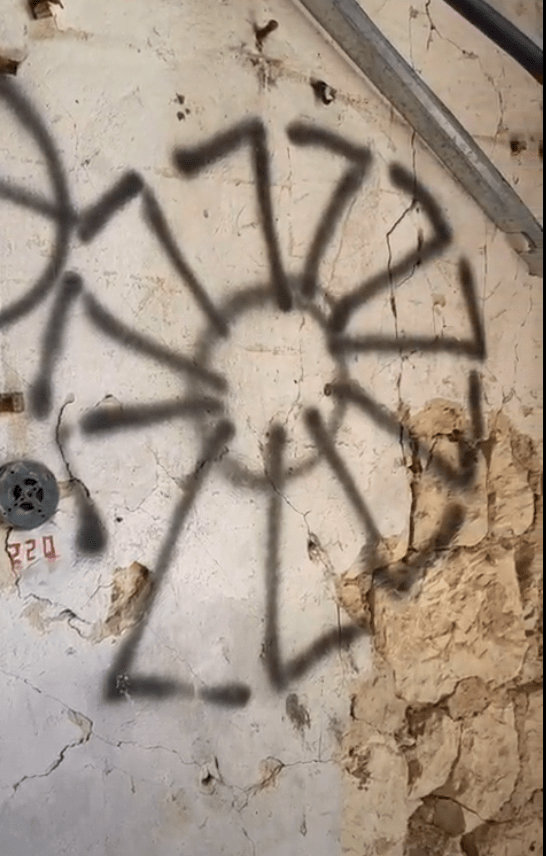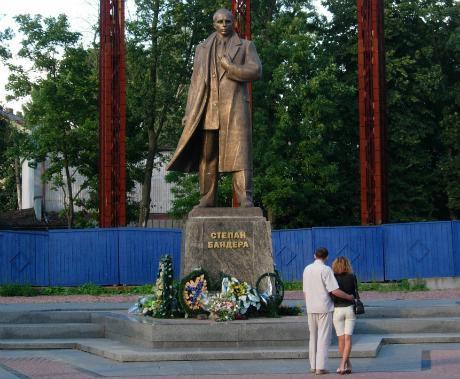War in Eastern Ukraine Looks a Lot Different in Person Than It Does on CNN

I had just left the Lugansk People’s Republic, making my way to an interview in Moscow, when I saw a May 11 CNN story claiming Russia had targeted civilians in the Ukrainian city of Odessa. This was after the bombing of a hotel and shopping center there. When such structures are bombed, one assumes that they were filled with civilians.
Odessa was also the location of a massacre that took place after the 2014 coup, which had been supported and financed by the U.S. The fascist element that was part of that coup burned the Odessa House of Trade Unions on May 2, 2014, killing progressives, socialists, trade unionists and anti-fascists.
My friend and guide during the Lugansk portion of my trip was Alexey Albu, who was inside that burning building and one of the few who escaped. At the time, Alexey was an elected member of the Odessa Regional Council. He was a former member of the Central Committee of the Communist Party of Ukraine and at that time the local coordinator of Union Borotba (Struggle).
He and others were working on solving the contradictions created in society by the coup in a peaceful way through the still-existing legislative processes.
However, by May 2, time had run out. The fascists who praised Nazi collaborators and pushed ultra-nationalism against the Russian population turned even more violent against any opposition. Political repression and jailings were on the rise by the coup government, and six days after the massacre, Alexey found out he was to be arrested. He and his family then fled to Crimea where they felt safe. He later went to Lugansk to continue his political work, but had to separate from his family for four years to do so.
As he is from Odessa and still has many connections there, I wanted to ask Alexey about the bombing on May 11. Alexey responded: “Yes, Russia attacked the luxury hotel Grande Pettine, because there were foreign mercenaries operating there. And the big shopping and entertainment center Riviera was attacked because they turned it into a warehouse for NATO weapons.”

“It’s also important to know that Russia used high-precision missiles, so as not to cause harm to civilians. And it is very interesting that CNN did not pay attention when more than 40 civilians were drowned in blood and burned in fire in the Trade Unions Building on the second of May 2014,” said Alexey.
Challenging U.S. narrative
The Russian intervention in Ukraine began February 24 at the request of the Donetsk and Lugansk People’s Republics (DPR and LPR). About a month later, unlikely sources—analysts and advisers working for the Pentagon—became whistleblowers in an exposé published by Newsweek, “Putin’s Holding Back.”
The authors, many of whom were military officers, had to remain anonymous in order to be as truthful as possible, since they were still working as advisers. The article challenged the official narrative that Russian President Putin was targeting civilians.
Regarding a similar earlier accusation by the corporate media about a Russian bombing, said to have targeted “peacekeeping facilities” (as if belonging to the UN), one of the analysts responded: “And the so-called peacekeeper training ground [in Yavoriv] was hit because it was the place where the ‘international legion’ [Ukrainian military unit, training international mercenaries] was to have trained.”
This quote from one of the advisers sums up their motivation for becoming whistleblowers:
“I’m frustrated by the current narrative—that Russia is intentionally targeting civilians, that it is demolishing cities, and that Putin doesn’t care. Such a distorted view stands in the way of finding an end before true disaster hits or the war spreads to the rest of Europe,” said this Pentagon adviser and U.S. Air Force officer.
It’s interesting that CNN reported that only one person died and five were hospitalized in the May 11 bombing. In a shopping center and hotel filled with people, as they implied, many more likely would have died.
One of the ways to determine whether someone is telling the truth when you have no access to events far away, under media whiteouts and the jailing of journalists, is to either catch the liar at other lies to bring their credibility into question, or find a way to get access to the location of the events.
We did both.
Fact-finding mission
On April 27, I began a trip to the LPR in the Donbas region as part of a fact-finding mission organized by Struggle-La Lucha newspaper in the U.S. to gather eyewitness observations and testimony from Lugansk residents, some of whom I found were living in shelters near the front lines of the war. The loud blasts are a constant reminder for them of the artillery of the Ukrainian military, targeting apartment buildings nearby and hopefully continuing to miss them.

Chairman of the Lugansk People’s Republic, Sergey Kozlov presents John Parker with Honorary Badge for Good Deeds. [Source: Photo by Lugansk Information Center]
This trip would not have been possible if not for our friends from Borotba, who we’ve been collaborating with for eight years. Borotba was founded in 2011 and was in the process of becoming a political party, but the Maidan coup interrupted that process.
While passing through Russia on the way to Lugansk, I spoke to progressive, socialist and communist organizations at the Moscow May Day celebrations and a commemoration of the Odessa Massacre on May 2.
I also interviewed visiting journalists from Belarus who were covering the May 9 Victory Day parade, commemorating the defeat of Nazi Germany and honoring the 27 million Soviet people who died fighting fascism—a fact which everyone should consider as context in today’s vilification of Russia. Soviet Russia, along with the rest of the USSR, was essential in order to defeat Nazi Germany in World War II.
Although Russia is no longer socialist, that does not change the fact that the parents and grandparents of most of the people in the country sacrificed for that victory. That deep understanding of the dangers of fascism did not disappear with the counterrevolution. Nor did the targeting of this region by U.S. imperialism end.
The U.S. government says that the current Russian intervention was an uninvited “invasion,” that the justification of self-defense and concern over the growth of fascist forces in the Ukrainian government and military is just a smokescreen designed to facilitate the takeover of that country. They claim the Russian military is targeting civilians and the Ukrainian military is not.
The Biden administration also says that it would be better for all of the people in the region if the Russian military withdrew its troops, with no acknowledgment of the eight-year Ukrainian war against the people of the Donbas region.
Surprisingly, a significant portion of organizations here in the U.S. that consider themselves anti-imperialist and socialist agree with the assessment pushed by the U.S. State Department.
The celebration of victory against the Nazis, by the way, is illegal in Ukraine. President Zelensky will not allow it. I know, the irony is unbelievable, but the fact remains—celebrating Victory Day in Kyiv and anywhere controlled by the Ukrainian regime is illegal.
In spite of Zelensky’s recent announcement giving lip service to the day for cover, the fact is that there was a curfew in place that day to discourage it. While in Lugansk, I asked someone what would happen if I were to have a sign celebrating Victory Day in Kyiv. The answer was that in five minutes I would no longer be carrying that sign, and probably would be taken to prison.
But perhaps that’s just a quirky policy meant for public safety? Let’s dig deeper.
Rubizhne: Life on the front line
“Don’t step there!” a soldier from the LPR warned me as my foot was about to step into the grass, away from the established path of the soldier walking in front of me.
This trek began in the morning, hitching a ride with the Lugansk People’s Militia to an area in the north of Lugansk, close to the front line of war against the Ukrainian military, where the LPR with the help of Russian soldiers recently liberated a residential area in Rubizhne. This city in Lugansk was previously occupied by Kyiv forces.
In front of a Ukrainian tank stopped by Lugansk People’s Militia and Russian soldiers. From left: Alexey Albu, John Parker, Evgeniy Miroshnichenko. [Source: Photo by member of Lugansk People’s Militia]
Here there was a shelter in an abandoned apartment complex. Unexploded armaments and even mines from the Ukrainian military littered the area, the soldier said.
Of course, I obliged and changed my path. I also immediately understood why no children were running around the grounds or using the playground. Instead, they mostly seemed to stay in the shelter or sometimes came out to play soccer in a small patch of land directly in front of it, under the watchful eye of a young LPR soldier.
At that moment my parental feelings kicked in and all I wanted to do was play with them, comfort them. But I had work to do.
This was once a lively apartment complex with a school and a beautiful playground. But now it looked like the backdrop to a “Walking Dead” episode.
Borotba’s Alexey Albu accompanied me and provided interpretation. The video clips linked here include some of these conversations and contain more footage from this portion of the trip.
We spoke with the woman in charge of the shelter, Larisa. She reluctantly took the position of caretaker for the shelter, voted in by the residents who trusted her. It definitely seemed like the right choice, because she keeps it in the best order that can be expected in these times. With all the work and responsibilities, she still manages to share compassion with those in need of comfort—war makes apparent the devils, but also the angels.
Basic foodstuffs and supplies—grains, water, and diapers—were neatly stored away. Getting food is especially a challenge for people who have nowhere else to go. Some residents who had alternative dwellings and were not disabled left Rubizhne, but the area is still not safe for travel. Many stayed to remain under the protection of the soldiers of both the LPR and Russia.
Russia provides humanitarian aid
Humanitarian aid arrives frequently in Rubizhne, delivered by Russian soldiers. (In the short time I was at the border entering Lugansk from Russia, I saw ten large trucks full of humanitarian aid entering the LPR.)
While we were at the shelter, two shipments of aid were delivered in a van, which we helped bring into the shelter. The box I was carrying almost broke open, with utensils and napkins barely making it to the bench where other items, especially diapers, were being placed.
Larisa explained that fuel, which is now hard to come by, had been used as their primary source for electricity, refrigeration and water (running the generator and water pump). So the aid is essential to prevent people from starving or dying of thirst.
“Because of the war, they had problems getting assistance to the shelter,” Alexey explained. The trade unions in charge of delivering food in Lugansk were not able to, due to the area becoming a war zone, meaning they had to hand over that task to the military.
Despite the danger and the fact that the Ukrainian military still controlled the area, the Russian and Lugansk soldiers, at great risk to their own lives, were able to get some aid to the residents of the shelter even before the area was liberated.

Russian humanitarian aid convoy in Lugansk. [Source: lug-info.com]
Recalling this moment, and the effect it had on her own child, brought Larisa to tears. She needed a minute to recover.
“Ukrainian soldiers did not help at all,” she said when she returned. “That is unacceptable. No one from the Ukrainian side asked us, visited us. I had supported Ukraine, but after I saw how they left these people I no longer supported them.”
Accompanying us was a journalist from an Italian media organization. He asked why people stayed here at the shelter, and if they were allowed to leave. Although Larisa made the facility as comfortable as possible, the conditions were hard and the constant thunder of bombings was heard during our entire time there.
Alexey explained that the roads here, although dangerous now, were even more dangerous during Ukrainian control, so leaving was not a safe option then. It became more possible after the area came under Russian control. “We tell people it is not safe, but if they want to leave, of course they can. No one will stop them,” explained Larisa.
Another issue Larisa wanted to address was the propaganda that has spread throughout Ukrainian society saying that the Russian soldiers rape and kill the people living in areas they have taken control of. She wanted to make it clear that this was not true.
“No, everything was very good, relations were very good and polite with the Russian soldiers. Even when we ask for some special foods like coffee or tea, they give it to us.”
Soldiers and civilians
To get a feel for the character of the relationship between the residents and the Russian and LPR soldiers, here is one encounter that stuck with me. When we visited the school in the complex, which is now a shelter, I saw a woman reprimanding one of the soldiers for having the humanitarian aid truck remain too long at the entrance.
Alexey said she was complaining that if they had to evacuate the school quickly, the truck would be in the way. The soldier politely nodded and agreed to move it soon, as if she was in charge. From her tone it seemed like that to me, and it definitely did not reflect a repressive relationship—not for the residents anyway.
Both in the village of Krymskoye and here in Rubizhne, folks talked about living underground, in their basements, to avoid being hit by bombs. In this shelter we walked down the stairs into a dark hall where we had to use the light from our phones to navigate, leading to the basement.
Everyone slept with cots on the concrete floors, with just a few feet of space between each other, to have some semblance of privacy and illusion of personal space. Paint chips were peeling from the green concrete walls. Most of those spaces contained many members of a family.
We interviewed a woman who looked like she was in her 80s. She was alone in her space. Unlike the majority in Lugansk, she spoke Ukrainian. She was bundled in layers of clothing, although the weather was nice around noon, in the 60s°F (18°C). At night, temperatures drop into the 40s°F (7°C) this time of year. Given the situation with no heat and her age, the layers made sense.
With a handkerchief hiding her tears, she spoke to us. “I have no relatives, I have no family,” she cried. Right away the caregiver of the shelter answered her: “Don’t worry, don’t worry—we are your family now.” Alexey, knowing Ukrainian, was able to interpret her words for us.
“Soldiers shot into my home and burned all my things. Everything that I own is right here,” she said, pointing to the bed she sleeps on. I could see nothing but blankets and pillows. Her age and situation makes leaving an even worse prospect.
After we were done, I tried to give her a hug, forgetting that we were required to wear bulletproof flak jackets and helmets the entire day. I accidentally head-bumped this 80-year-old woman. I panicked, thinking I would hurt her, but it did not affect her one bit. Our compassion and willingness to listen to her story, however, did affect her.
If only the compassion for the images, sometimes real, sometimes manufactured, used to promote support for U.S. war escalation against people in Lugansk and Donetsk, would extend to actual people like this woman, with the added compassion to at least listen to their stories!
Can’t eat Biden’s weapons
We then heard from a family of three—a mother, son and grandson. The son and grandson were both adults. The mother and son were disabled and therefore unable to find any employment in this environment, let alone travel.
They, like many others, were dependent on the humanitarian aid given by Russia. They cannot eat Biden’s high-tech weaponry sent to the Kyiv regime. So they remain here.
They shared a similar story of having to leave a building that was being shot at. Although they said they could not say for sure who was shooting at them, they were sure the shells were coming from where the Ukrainian military brigades were stationed.
I then asked them if they felt safe here in the shelter. They all said they did and that they did not know what they would do without this place.
I also wanted to know how they felt about the Russian soldiers being at the shelter. Both Russian and Lugansk People’s Republic troops are present in this location, with the greatest number being LPR soldiers. But I wanted to specifically know how they felt about the Russian troops. So I asked them: “If the Russian soldiers left this shelter, how would that affect you?” The son and grandson answered immediately that they would not feel safe, and the mother nodded agreement.
The last interview we did in that basement was more detailed, regarding the circumstances of a family of four (five if you count the big gray cat held protectively by the teenage daughter).
The grandmother spoke to us about how they came to be there. She said that, although this family was Russian, their neighbors were Ukrainian. When the Ukrainian soldiers came to their area, they told those soldiers that they did not have to worry because there were no Russian troops there. About a half hour later, the Ukrainian tanks came and began shooting into the houses.
“The dogs were very frightened and my neighbors were running out of their burning houses,” said the grandmother. “They were shouting, ‘What are you doing, why are you shooting at us? We are Ukrainians.’ When they asked that, the soldiers just laughed and turned their faces away from the burning houses.”
She said: “I had to see who exactly was doing this, so I went outside and found some soldiers standing around and asked them, ‘Why are you shooting at my neighbors’ houses?’ No one answered me. But about 20 minutes later another Ukrainian tank came and shot directly into my house.”
When asked by another journalist how she felt about this situation, she recalled the hardship for her children and grandchildren after the 2014 coup. “They [the Ukrainian government] did not like that we used our native language [Russian]. So all schools, all kindergartens, changed their program to Ukrainian. But they are children who learned their language in homes that speak Russian. So we continued to teach our children in Russian.”
“My granddaughter and great-granddaughter both pleaded with me: ‘Please, I want to change schools because I don’t understand.’ But we couldn’t do anything about it. And with exact sciences like mathematics they had bigger difficulties because they couldn’t understand what was written.
“This shows how the Nazis feel about us and why they killed us and harmed our homes and organized shellings against us—they don’t consider us as their people.”

Black Sun Nazi symbol we found at building in village of Krymskoye that had been occupied by Ukrainian military. [Source: Photo courtesy of John Parker]
The Italian journalist asked: “So they were not locals, these were western Ukrainians?”
“Yes,” she replied, “I think they were western Ukrainians.”
This is just a small reflection of the Ukrainian nationalist tendencies that grew out of the 2014 regime change and inspired the Donbas regions of Lugansk and Donetsk to become independent republics. Ukraine, instead of honoring Victory Day on May 9, now honors Nazi collaborators—like the notorious Stepan Bandera—with statues and street names.

Monument to Stepan Bandera in Lviv. [Source: opendemocracy.net]
Under Ukrainian bombs
It happened while we were there! A nearby apartment was bombed by Ukrainian artillery while we were interviewing the families in the basement shelter.
Another irony hit me (like the bomb attempted to do): My tax dollars were a portion of the billions spent on weapons like the one that just targeted the area where I and the people I was interviewing stood. Thanks for that, President Biden and all the Republicans and Democrats on board with escalating this proxy war against Russia.
Fortunately, that apartment building close to us was already abandoned, unlike the demolished homes of the 350 people who were using and had used this shelter.
The bombing is so constant that it almost fades away in the background. But reminders like the shelling of the nearby apartment bring them, and the fear, back up to the conscious mind.
The constant threat of bombings also makes cooking a challenge. Right outside the shelter are two areas for cooking. Since there are no gas stoves due to lack of fuel, the cooking has to be done outside in self-made fire pits—and as illustrated by the recent bombing, it has to be done fast so as not to be outside too long.
“We cook bread and a very tasty dessert specific to Lugansk here,” said Larisa. I asked her if she and the others who cook outside get worried about their safety. “Yes, of course we are afraid, but we need to cook because everyone needs to eat something.”
Today we find ourselves once again being sold a war by the U.S. government, this time against Russia. And—as in all U.S. imperialist wars—the corporate media follow along, dutifully reporting and publishing every video and “news story” they become aware of, with sources unknown at best and dubious at worst.
These hidden parts are the other side of that story, the more truthful side.
Next: School’s out for now; take a tour of the after-effects of two opposing camps separated by ideology; and more voices from Lugansk, in the once Ukrainian-occupied village of Krymskoye.
*
Note to readers: Please click the share buttons above or below. Follow us on Instagram, Twitter and Facebook. Feel free to repost and share widely Global Research articles.
John Parker is a 2022 Socialist Unity Party and Peace and Freedom Party candidate for the U.S. Senate from California. Parker has been a union organizer, public school teacher, and is a coordinator of the International Action Center. John can be reached at [email protected].
Featured image: Nazi swastika symbol we found at building in village of Krymskoye that had been occupied by Ukrainian military. [Source: Photo courtesy of John Parker]
This article has been archived for your research. The original version from Global Research can be found here.


